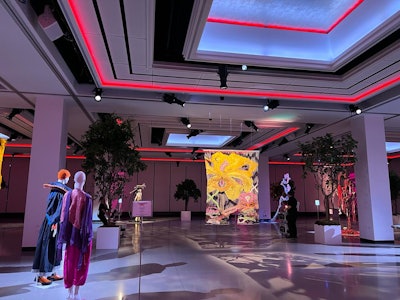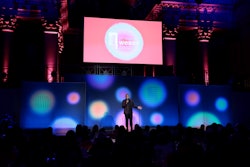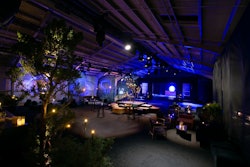
Today’s digital age has created a type of buzzword economy where the hot topics of the moment shoot to stardom in their respective markets (hello, “immersive,” “metaverse,” and “wellness,” just to name a recent few in the events industry). For their moment in the sun, these buzzwords have the power to move markets and drive business decisions. However, a select few have staying power, and Brooklyn-based event planning firm JWP (Josh Wood Productions) is out to prove that “sustainability” is one of them.
To do so, JWP recently launched a dedicated sustainability division to go beyond using paper plates instead of plastic, to squash the ideology that more sustainable equals more expensive, and to change the future of events in a meaningful and collaborative way. And it all started with the 2006 release of An Inconvenient Truth, an Oscar-winning documentary about the environment and former presidential candidate Al Gore’s campaign to educate the public on the climate issues we’re facing.
Josh Wood, JWP’s CEO and founder, and Mimi Eayrs, JWP’s COO and partner, were moved by the film, and later got involved in Gore’s Climate Reality, a solutions-based organization that focuses on the ongoing battle to bettering our environment.
“Mimi and I started becoming very familiar with the organization, and then we started talking about how we wanted to weave those values into our work,” Wood explained in an interview with BizBash. Later, “we became trained as climate activists,” he said, and Eayrs chimed in that the program was so impactful that she was implementing more eco-friendly habits into her everyday life. Josh Wood (left), JWP’s CEO and founder, and Mimi Eayrs (right), JWP’s COO and partnerPhoto: Courtesy of JWP
Josh Wood (left), JWP’s CEO and founder, and Mimi Eayrs (right), JWP’s COO and partnerPhoto: Courtesy of JWP
“I’ve been in New York for over 20 years, and there’s been a shift of not using plastic bags, and I made the move to using a wooden toothbrush. And you see all these people shopping at their local markets. But then, [Josh and I] were realizing that we were in an industry that was incredibly wasteful,” Eayrs said.
Contrary to what many may believe, infiltrating the events industry with sustainable practices was no easy feat, especially in 2016 when Wood and Eayrs were first pushing for change. The way in? Putting on an event for an organization that was equally interested in transforming events for the better. (The Parsons Benefit in 2016 was the first event JWP produced where sustainability guided decisions.)
Now, the word “sustainability” may be buzzing throughout the industry, but what’s the key to keeping it sexy? “Realizing that nothing has to be perfect,” Wood said.
Eayrs added that sustainable practices very much go hand in hand with the cultural moment. Take “shifting from a printed invitation to a digital invitation,” for example, or “from a printed program to having iPads at the table with a program,” she said, because that’s how people these days are consuming content in all forms anyway.
And when asked what advice she would give planners looking to add some eco-friendly practices into their to-dos, Eayrs urged planners to look to “locally grown produce and products” for their menus as much as possible, or to “use plants, air plants, or succulents” instead of florals for centerpieces that guests can also take home as a fun favor.
Planners could even take it a step further and make the meal a centerpiece. “We’ve worked with caterers to do a beautiful family-style meal that was the centerpiece,” Eayrs said. “We used food as edible decor, if you will, and the food looked vibrant and inviting.” However, if a shared meal isn’t going to work for your event, going “pescetarian or vegetarian” is always going to be more sustainable than meat-heavy offerings, Eayrs advised.
“And we love using found objects,” Wood said of being more sustainable with nonedible decor and furniture rentals. “We find things that are already in storage [or] get things people have made.”
He continued: “I think people’s expectations that a table has to be round with 10 seats and a floral arrangement in the middle is outdated. You don’t need to do that. You can buy secondhand plates—there are so many things you can buy secondhand and then reuse rather than renting it.” The Parsons Benefit in 2016 was the first event JWP produced where sustainability guided decisions, and the Brooklyn-based event firm still produces the annual affair.Photo: Courtesy of JWP
The Parsons Benefit in 2016 was the first event JWP produced where sustainability guided decisions, and the Brooklyn-based event firm still produces the annual affair.Photo: Courtesy of JWP
Wood also advised planners to reconsider making their guests travel to a destination and instead take advantage of “immersive projection technology” that can be experienced IRL and through a screen. Not only does it give you the chance to “engage with people that are really creative,” but “we can create something innovative and beautiful while delivering the look, feel, and message the client wants in a way that generates zero waste.”
Ultimately, this is what JWP’s sustainability division is all about—advising clients on the new, noteworthy, and not-commonly-thought-of ways that sustainable practices can be woven through their event.
With that, being more sustainable does not mean dishing out more dollars. For one, going digital with invites instead of printing cuts costs, as does reusing furniture that was in storage from a previous event that will be put to use at a future event. And when you’re not paying for travel because you have highly immersive digital programming, costs are cut… again.
And while sustainability may cut costs, carbon emissions, and meat off a menu, the event planner and attendee alike are not losing anything. In fact, being more sustainable is a far greater addition to an affair than a deduction, and will contribute positively to a larger cultural conversation, converting “sustainability” from a buzzword to an industry mainstay.



















